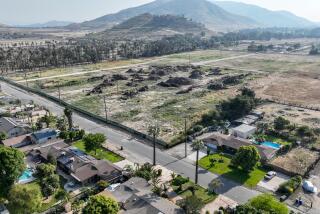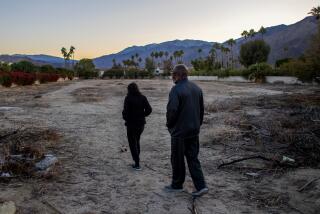A most unwelcome housing boom
- Share via
ORLANDO, FLA. — When residents of several neighborhoods near Orlando International Airport go to bed, they wonder what most homeowners don’t: Is there a bomb under my house?
They recently learned their 8-year-old developments were built on a World War II bombing range that wasn’t thoroughly cleared. Now they’re scared for their lives and investments and angry with developers and local government officials who residents claim shouldn’t have allowed the homes in the first place.
There are hundreds of former bombing and artillery training ranges across the U.S., but few have 2,000 homes sitting on top of them.
Since the U.S. Army Corps of Engineers began sweeping the Orlando neighborhoods a year ago, it has found more than 200 munitions and other potentially volatile remnants. Some weighed up to 23 pounds. Most were recovered on the grounds of a middle school, including one lodged beneath the landing pit for the long jump.
The corps says it’s extremely unlikely any of the buried munitions would detonate, but that’s done little to calm nerves. The value of the homes -- which originally cost $200,000 to $600,000 -- has dropped by at least a third, residents say. That’s compared with a roughly 20% decline across Florida caused by the real estate slump.
That’s if the homes can be sold at all. Some homeowners involved in class-action lawsuits over the site say banks have told them the properties aren’t worth anything to lend against.
“This has been a failure of the government,” said Ron Cumello, head of a local homeowners association, during one of several meetings with the corps and local officials. “You guys have to win back our trust.”
The developers, home builders, corps and local government officials who zoned the land all blame one another. Corps officials say they long ago told local governments about the bombs, but current officials say their records were stripped of the information. The home builders say no one told them.
Lori Hartigan, a 36-year-old nurse, says crews found one of the munitions near her driveway. Though many rounds dropped by pilots during training were dummies, the rusty 5-inch cylinder in her yard was a live fuse packed with combustible powder. It’s not clear how dangerous the device would have been if it exploded, but she shuddered to think what could have happened if she backed her car over it.
She now feels stuck in a home she bought five years ago and wants her money back from Lennar Corp., which built many of the homes.
At nearby Odyssey Middle School, a corps contractor was injured when he disturbed the old munition under the long-jump pit at the school’s track. The item started to burn but did not explode.
The former Pinecastle Jeep Range is one of about 9,000 “formerly used defense sites” the corps oversees. The site isn’t the first to go residential.
A subdivision in Arlington, Texas, was built on an old bombing range in the early 2000s, spurring several lawsuits and a cleanup that began in 2005 and continues today. The corps’ top priority is Spring Valley in Washington, D.C., where residents live above ground polluted by World War I chemical weapons testing and unexploded munitions.
The corps has produced dozens of documents dating to the 1940s that detail the Orlando site’s history as a bombing range, and corps spokeswoman Amanda Ellison says they have always been public records.
Ellison said reports on the range from late 1990s were shared with the local officials who compiled information before the homes and schools went up. But that information was somehow stripped before the housing was approved. Current city officials haven’t been able to determine how or why that happened.
“We’ve looked back and, for all intents and purposes, there just is no smoking gun in this case,” Orlando spokesman Carson Chandler said.
Lennar Corp. hired its own inspection crews to find munitions around the homes it built, inciting a legal battle with the corps over those expenses.
“The ultimate responsibility for taking care of this problem lies with the only entity responsible for causing this problem” -- the corps, said Wayne Broedel, Lennar division president, in a written statement.
Newland Communities, the San Diego-based company that developed the affected areas, declined to comment through an attorney, citing pending litigation. So did home builders Taylor Morrison and K. Hovnanian.
Esperanza Hernandez is worried she’ll lose her home, bombs or not. She invested $75,000 on the $274,000 purchase with an adjustable rate mortgage, and now fears it’s not worth close to that.
“My problem is I am 62 years old, and this is the only home I have,” Hernandez said. “Nobody wants to buy a house in this community.”
More to Read
Sign up for Essential California
The most important California stories and recommendations in your inbox every morning.
You may occasionally receive promotional content from the Los Angeles Times.










